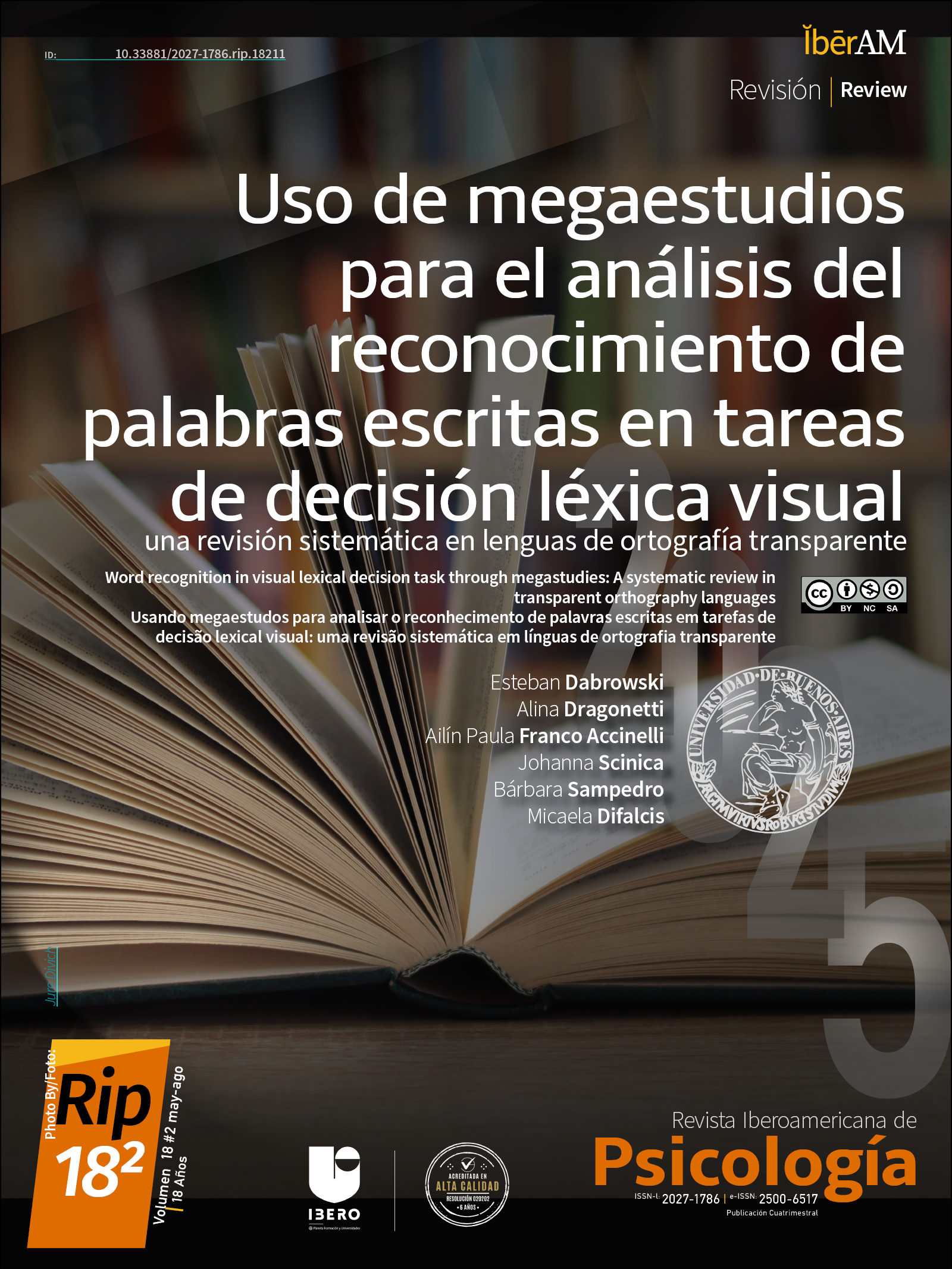Uso de megaestudios para el análisis del reconocimiento de palabras escritas a partir de tareas de decisión léxica visual: una revisión sistemática en lenguas de ortografía transparente
Uso de megaestudios para el análisis del reconocimiento de palabras escritas a partir de tareas de decisión léxica visual: una revisión sistemática en lenguas de ortografía transparente
Main Article Content
This systematic review aimed to examine the use of megastudies conducted to analyze word recognition in visual lexical decision task in languages considered to have transparent orthography. Specifically, it sought to explore, on one hand, the methodological criteria for the design and administration of the task. On the other hand, it aimed to analyze the characteristics of the databases that resulted from these megastudies. A systematic review of the available literature from the past 15 years up to March 2024 was conducted across various databases (PubMed, Scopus, PsycInfo, and SciELO). A search was performed for original articles that had conducted megastudies to evaluate written word recognition in visual lexical decision tasks, including studies involving children and adults without processing impairments. The search yielded a total of 133 articles, of which eight met the inclusion criteria. Half of the megastudies included a large number of participants, while the other half included a large number of stimuli and a large number of participants. It can be concluded that the visual lexical decision task is highly relevant for psycholinguistic studies of word recognition, that the available databases provide valuable contributions for future analyses, and that there is a need for megastudies in different transparent orthography languages that do not yet have them.
Publication Facts
Reviewer profiles N/A
Author statements
- Academic society
- Bogotá: Corporación Universitaria Iberoamericana
- Publisher
- Bogotá: Corporación Universitaria Iberoamericana
Article Details
*Artículos incluidos en esta revisión
Adelman, J. S., Johnson, R. L., McCormick, S. F., McKague, M., Kinoshita, S., Bowers, J. S., Perry, J. R., Lupker, S. J., Forster, K. I., Cortese, M. J., Scaltritti, M., Aschenbrenner, A. J., Coane, J. H, White, L., Yap, M. J., Davis, C., Kim, J., & Davis, C.J. (2014). A behavioral database for masked form priming. Behavior Research Methods, 46(4), 1052-1067. https://doi.org/10.3758/s13428-013-0442-y
*Aguasvivas, J. A., Carreiras, M., Brysbaert, M., Mandera, P., Keuleers, E. & Duñabeitia, J. A. (2018). SPALEX: A Spanish lexical decision database from a massive online data collection. Frontiers in psychology, 9, 2156. https://doi.org/10.3389/fpsyg.2018.02156
Aguasvivas, J., Carreiras, M., Brysbaert, M., Mandera, P., Keuleers, E. & Duñabeitia, J. A. (2020). How do Spanish speakers read words? Insights from a crowdsourced lexical decision megastudy. Behavior research methods, 52, 1867-1882. https://doi.org/10.3758/s13428-020-01357-9
Aro, M. & Wimmer, H. (2003). Learning to read: English in comparison to six more regular orthographies. Applied Psycholinguistics, 24, 621–635. https://doi.org/10.1017/S0142716403000316
Balota, D. A., Cortese, M. J., Sergent-Marshall, S. D., Spieler, D. H., & Yap, M. J. (2004). Visual word recognition of single-syllable words. Journal of Experimental Psychology: General, 133(2), 283-316. https://doi.org/10.1037/0096-3445.133.2.283
Balota, D. A., Yap, M. J., Hutchison, K. A., Cortese, M. J., Kessler, B., Loftis, B., Neely, J., Nelson, D. L., Simpson, G.B. & Treiman, R. (2007). The english lexicon project. Behavior Research Methods, 39, 445–459. https://doi.org/10.3758/BF03193014
Borleffs, E., Maassen, B. A., Lyytinen, H., & Zwarts, F. (2017). Measuring orthographic transparency and morphological-syllabic complexity in alphabetic orthographies: a narrative review. Reading and writing, 30, 1617-1638. https://doi.org/10.1007/s11145-017-9741-5
Brysbaert, M., Stevens, M., De Deyne, S., Voorspoels, W. & Storms, G. (2014). Norms of age of acquisition and concreteness for 30,000 Dutch words. Acta Psychologica, 150, 80-84. https://doi.org/10.1016/j.actpsy.2014.04.010
*Brysbaert, M., Stevens, M., Mandera, P. & Keuleers, E. (2016). The impact of word prevalence on lexical decision times: Evidence from the Dutch Lexicon Project 2. Journal of Experimental Psychology: Human Perception and Performance, 42(3), 441. https://doi.org/10.1037/xhp0000159
*Brysbaert, M., Keuleers, E. & Mandera, P. (2019). Recognition times for 54 thousand Dutch words: Data from the Dutch Crowdsourcing Project. Psychologica Belgica, 59(1), 281. https://doi.org/10.5334/pb.491
Castro, N., & Vitevitch, M. S. (2023). Using network science and psycholinguistic megastudies to examine the dimensions of phonological similarity. Language and Speech, 66(1), 143-174. https://doi.org/10.1177/00238309221095455
Cuetos, F., & Domínguez, A. (2002). Efecto de la pseudohomofonía sobre el reconocimiento de palabras en una lengua de ortografía transparente. Psicothema, 14(4), 754–759. Recuperado a partir de https://reunido.uniovi.es/index.php/PST/article/view/7914
Diependaele, K., Brysbaert, M. & Neri, P. (2012). How noisy is lexical decision?. Frontiers in psychology, 3, 348. https://doi.org/10.3389/fpsyg.2012.00348
Difalcis, M., Leiva, S., Ferreres, A., & Abusamra, V. (2018). Reconocimiento de palabras en español en una tarea de decisión léxica visual con pseudohomófonos. Nueva revista del Pacífico, 69, 34–51. http://dx.doi.org/10.4067/S0719-51762018000200034
Difalcis, M., & Morello García, F. (2023). Uso de pseudohomófonos en lectura y reconocimiento de palabras: Una revisión sistemática en ortografías transparentes. Revista Psicología UNEMI. 7(12), 123-127. https://doi.org/10.29076/issn.2602-8379vol7iss12.2023pp123-137p
Difalcis, M., Morello García, F., Abusamra, V., & Ferreres, A. (2021). Types of acquired dyslexia in Spanish-speaking patients with aphasia. Cognitive Neuropsychology, 38(4), 283-301. https://doi.org/10.1080/02643294.2021.1989394
Dufau, S., Duñabeitia, J. A., Moret-Tatay, C., McGonigal, A., Peeters, D., Alario, F-X., Balota, D., Brysbaert, M., Carreiras, M., Ferrand, L., Ktori, M., Perea, M., Rastle, K., Sasburg, O., Yap, M. J., Ziegler, J. C. & Grainger, J. (2011). Smart phone, smart science: How the use of smartphones can revolutionize research in cognitive science. PLoS ONE, 6(9), e24974. https://doi.org/10.1371/journal.pone.0024974
Ferrand, L., New, B., Brysbaert, M., Keuleers, E., Bonin, P., Meot, A., Augustinova, M., & Pallier, C. (2010). The French Lexicon Project: Lexical decision data for 38,840 French words and 38,840 pseudowords. Behavior Research Methods, 42, 488-496. https://doi.org/10.3758/BRM.42.2.488
Ferrand, L., Brysbaert, M., Keuleers, E., New, B., Bonin, P., Meot, A., Augustinova, M., & Pallier, C. (2011). Comparing word processing times in naming, lexical decision, and progressive demasking: evidence from Chronolex. Frontiers in Psychology, 2, 1-10. https://doi.org/10.3389/fpsyg.2011.00306
Ferrand, L., Méot, A., Spinelli, E., New, B., Pallier, C., Bonin, P., … & Grainger, J. (2018). MEGALEX: A megastudy of visual and auditory word recognition. Behavior Research Methods, 50(3), 1285-1307. https://doi.org/10.3758/s13428-017-0943-1
Frisson, S., Koole, H., Hughes, L., Olson, A., & Wheeldon, L. (2014). Competition between orthographically and phonologically similar words during sentence reading: evidence from eye movements. Journal of Memory and Language, 73, 148–173. https://doi.org/10.1016/j.jml.2014.03.004
Goh, W., Yap, M., & Chee, Q. (2020). The Auditory English Lexicon Project: A multi-talker, multi-region psycholinguistic database of 10,170 spoken words and nonwords. Behavior Research Methods, 52, 2202–2231. https://doi.org/10.3758/s13428-020-01352-0
*González-Nosti, M., Barbón, A., Rodríguez-Ferreiro, J. & Cuetos, F. (2014). Effects of the psycholinguistic variables on the lexical decision task in Spanish: A study with 2,765 words. Behavior Research Methods, 46, 517-525. https://doi.org/10.3758/s13428-013-0383-5
González-Valenzuela, M. J., López-Montiel, D., Chebaani, F., Cobos-Cali, Piedra-Martínez, E., & Martin-Ruiz, I. (2023). Predictors of word and pseudoword reading in languages with different orthographic consistency. Journal of Psycholinguistic Research, 52(1), 307-330. https://doi.org/10.1007/s10936-022-09893-5
*Guasch, M., Boada, R., Duñabeitia, J. A. & Ferré, P. (2022). Prevalence norms for 40,777 Catalan words: An online megastudy of vocabulary size. Behavior Research Methods, 55, 3198-3217. https://doi.org/10.3758/s13428-022-01959-5
Güven, S., & Friedmann, N. (2022). Even in predictable orthographies: Surface dyslexia in Turkish. Scientific Studies of Reading, 26(6), 489-513. https://doi.org/10.1080/10888438.2022.2058399
Grigorenko, E. L. (2001). Developmental dyslexia: An update on genes, brains, and environments. The Journal of Child Psychology and Psychiatry and Allied Disciplines, 42(1), 91-125. https://doi.org/10.1017/S0021963001006564
Hawelka, S., Schuster, S., Gagl, B., & Hutzler, F. (2013). Beyond single syllables: the effect of first syllable frequency and orthographic
similarity on eye movements during silent reading. Language and Cognitive Processes, 28(8), 1134–1153. https://doi.org/10.1080/01690965.2012.696665
Hutchison, K. A., Balota, D. A., Neely, J. H., Cortese, M. J., Cohen-Shikora, E. R., Tse, C. S., Yap, M. J, Bengson, J. J., Niemeyer, D., & Buchanan, E. (2013). The semantic priming project. Behavior Research Methods, 45(4), 1099-1114. https://doi.org/10.3758/s13428-012-0304-z
Katz, L. & Frost, R. (1992). The Reading Process is Different for Different Orthographies: The Orthographic Depth Hypothesis. En R. Frost y L. Katz (Eds.), Orthography, phonology, morphology, and meaning. North-Holland. https://doi.org/10.1016/S0166-4115(08)62789-2
Keuleers, E. & Balota, D. A. (2015). Megastudies, crowdsourcing, and large datasets in psycholinguistics: an overview of recent developments. The Quarterly Journal of Experimental Psychology, 68, 1457–1468. https://doi.org/10.1080/17470218.2015.1051065
*Keuleers, E., Diependaele, K. & Brysbaert, M. (2010). Practice effects in large-scale visual word recognition studies: A lexical decision study on 14,000 Dutch mono-and disyllabic words and nonwords. Frontiers in psychology, 1, 174. https://doi.org/10.3389/fpsyg.2010.00174
Keuleers, E., Lacey, P., Rastle, K., & Brysbaert, M. (2012). The British lexicon project: lexical decision data for 28,730 monosyllabic and disyllabic english words. Behavior Research Methods, 44, 287–304. https://doi.org/10.3758/s13428-011-0118-4
Keuleers, E., Stevens, M., Mandera, P., & Brysbaert, M. (2015). Word knowledge in the crowd: Measuring vocabulary size and word prevalence in a massive online experiment. The Quarterly Journal of Experimental Psychology, 68, 1–62. https://doi.org/10.1080/17470218.2015.10225
Kuperman, V. (2015). Virtual experiments in megastudies: a case study of language and emotion. The Quarterly Journal of Experimental Psychology. 68, 1693–1710. https://doi.org/10.1080/17470218.2014.989865
Lachmann, T., & Bergström, K. (2023). Developmental dyslexia and culture: the impact of writing system and orthography. Journal of Cultural Cognitive Science, 7(2), 63-69. https://doi.org/10.1007/s41809-023-00129-z
Landerl, K., & Wimmer, H. (2008). Development of word reading fluency and spelling in a consistent orthography: an 8-year follow-up. Journal of educational psychology, 100(1), 150-161. https://psycnet.apa.org/doi/10.1037/0022-0663.100.1.150
Marmo, J., Zambrano Villalba, M. C., & Losada, A. (2022). Propuestas metodológicas en estudios de revision sistemática, metasíntesis y metaanálisis. Psicología UNEMI, 6(11), 32–43. https://doi.org/10.29076/issn.2602-8379vol6iss11.2022pp32-43p
Mason, W., & Suri, S. (2011). Conducting behavioral research on Amazon’s Mechanical Turk. Behavior Research Methods, 44(1), 1–23. https://doi.org/10.3758/s13428-011-0124-6
Miller, J. (2024). Estimating the proportions and latencies of reaction time outliers: A pooling method and case study of lexical decision tasks. Behavior Research Methods, 7280-7306. https://doi.org/10.3758/s13428-024-02419-y
Moreno Fernández, F., & Álvarez Mella, H. (2024). Demografía del español en el mundo 2024. En El español en el mundo 2024. Anuario del Instituto Cervantes. Madrid: Instituto Cervantes. Disponible en: https://cvc.cervantes.es/lengua/anuario/anuario_24/moreno-alvarez/p01.htm
Munro, R., Bethard, S., Kuperman, V., Lai, V. T., Melnick, R., Potts, C., Schnoebelen, T., & Tily, H. (2010). Crowdsourcing and language studies: The new generation of linguistic data. En: C. Callison Burch & M. Dresde (Eds.), Proceedings of the NAACL HLT 2010 workshop on creating speech and language data with Amazon’s Mechanical Turk. Los Ángeles: Association for Computational Linguistics. https://dl.acm.org/doi/10.5555/1866696.1866715
Norris, D. (2013). Models of visual word recognition. Trends in Cognitive Sciences, 17(10), 517-524. https://doi.org/10.1016/j.tics.2013.08.003
Page, M. J., McKenzie, J. E., Bossuyt, P. M., Boutron, I., Hoffmann, T. C., Mulrow, C. D., Shamseer, L., Tetzlaff, J. M., Aklh, E. A., Brennana, S. E., Choui, R., Glanvillej, J., Grimshawk, J. M., Hro´ bjartssonl, A., Lalum, M. M., Lin, T., Lodero, E. W., Mayo-Wilsonp, E., McDonald, S., ... &
Moher, D. (2021). Declaración PRISMA 2020: una guía actualizada para la publicación de revisiones sistemáticas. Revista Española de Cardiología, 74(9), 790–799. https://doi.org/10.1016/j.recesp.2021.06.016
Paulesu, E., McCrory, E., Fazio, F., Menoncello, L., Brunswick, N., Cappa, S. F., . . . Frith, U. (2000). A cultural effect on brain function. Nature Neuroscience, 3, 91–96. https://doi.org/10.1038/71163
Perfetti, C. A., & Dunlap, S. (2008). Learning to read General principles and writing system variations. En K. Koda & A. M. Zehler (Eds.) Learning to Read Across Languages. Nueva York: Routledge. https://doi.org/10.4324/9780203935668
Perfetti, C. A., & Harris, L. N. (2013). Universal reading processes are modulated by language and writing system. Language Learning and Development, 9(4), 296-316. https://doi.org/10.1080/15475441.2013.813828
Perry, C. (2023). Graphemes are used when reading: Evidence from Monte Carlo simulation using word norms from mega-studies. Quarterly Journal of Experimental Psychology, 76(2), 419-428. https://doi.org/10.1177/17470218221086533
Querido, L., Fernandes, S., Verhaeghe, A., & Marques, C. (2020). Lexical and sublexical orthographic knowledge: Relationships in an orthography of intermediate depth. Reading and Writing, 33, 2459-2479. https://doi.org/10.1007/s11145-020-10052-2
Schnoebelen, T., & Kuperman, V. (2010). Using Amazon Mechanical Turk for linguistic research. Psihologija, 43(4), 441–464. https://doi.org/10.2298/PSI1004441S
*Schröter, P., & Schroeder, S. (2017). The Developmental Lexicon Project: A behavioral database to investigate visual word recognition across the lifespan. Behavior Research Methods, 49, 2183-2203. https://doi.org/10.3758/s13428-016-0851-9
Seymour, P. H., Aro, M., Erskine, J. M., & Collaboration with COST Action A8 Network. (2003). Foundation literacy acquisition in European orthographies. British Journal of psychology, 94(2), 143-174. https://doi.org/10.1348/000712603321661859
Share, D. L. (2008). On the Anglocentricities of current reading research and practice: The perils of overreliance on an “outlier” orthography. Psychological Bulletin, 134(4), 584–615. https://doi.org/10.1037/0033-2909.134.4.584
*Soares, A. P., Lages, A., Silva, A., Comesaña, M., Sousa, I., Pinheiro, A. P., & Perea, M. (2019). Psycholinguistic variables in visual word recognition and pronunciation of European Portuguese words: a mega-study approach. Language, Cognition and Neuroscience, 34(6), 689-719. https://doi.org/10.1080/23273798.2019.1578395
VandenBos, G. R., & Winkler, J. M. (2015). An analysis of the status of journals and research in psychology from Latin America. Psicologia: Reflexão e Crítica, 28, 82-93. https://doi.org/10.1590/1678-7153.20152840012
Verhoeven, L., & Perfetti, C. (2022). Universals in learning to read across languages and writing systems. Scientific Studies of Reading, 26(2), 150-164. https://doi.org/10.1080/10888438.2021.1938575
Ziegler, J. C., Bertrand, D., Lété, B., & Grainger, J. (2014). Orthographic and phonological contributions to reading development: Tracking developmental trajectories using masked priming. Developmental Psychology, 50(4), 1026–1036. https://doi.org/10.1037/a0035187 Foundation literacy acquisition in European orthographies












